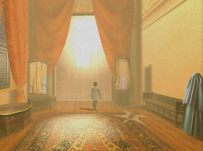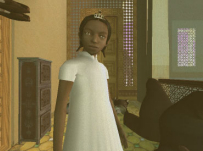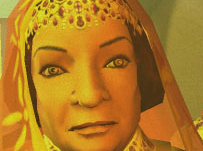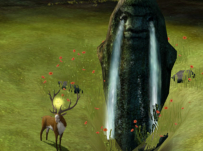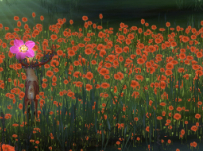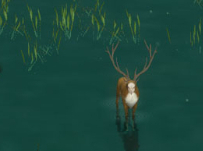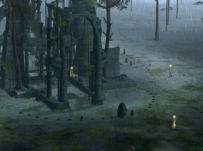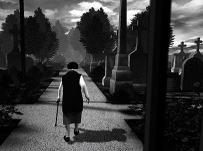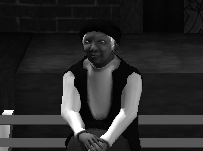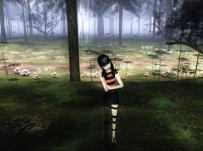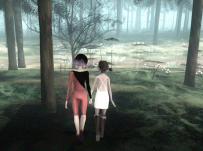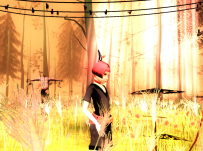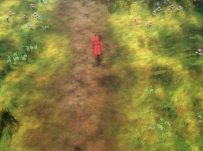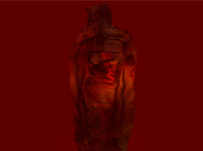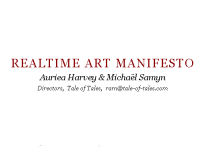Tale of Tales
La Nouvelle Vague

Perfil
- 17 / 03 / 09
Tale of Tales Interview - Part II
CG : With THE ENDLESS FOREST you have conceived an experience unlike any other in an online videogame, where communication is conditioned to different forms of expression. Were you somehow motivated to complete this project as a result of the basic level of communications seen in most online games?
A & M : We have always had a problem with language. Because it puts the speaker in a certain location and a certain culture. And that's not always what we want. Furthermore, the choice of language always puts the non-native speakers at a disadvantage. On top of that, of course, when conceiving a multiplayer game, we had great concern about social behavior.
So we removed every possible way in which people could hurt each other. Language being one of them. With THE ENDLESS FOREST, we wanted to create the illusion of a perfectly harmonious society, because everything any player does in the game, could always be interpreted as nice and friendly and fun by another. Even if if wasn't intended as such.
CG : It must have been quite an encouragement, seeing an unpretentious game such as The Graveyard being nominated for the prestigious IGF awards. I recall Michael’s answer the first time I asked you about this award - he seemed pessimistic. Do you think that players are prepared to play a game such as THE GRAVEYARD? Do you ever fear that most people who played it might just not be able to read the entire message you conveyed for them?
A & M : Many people would disagree with you and call THE GRAVEYARD extremely pretentious.
We don't mind either way. If we sound pessimistic, it's mostly because we feel a bit lonely. It would be nice if more independent developers were working in the same field as we are. Especially considering how important we consider this work to be, and how much still remains to be done. There's us, and there's thatgamecompany, and there's Icepick Lodge. That's about it. An international movement, for sure. But a very thin one.
Given the hundred thousand or so downloads of the trial version, we think there's quite a bit of willingness to play The Graveyard. This willingness does not automatically lead to appreciation. This tends to be highly personal. We like it that way. We want to make games that end up being about you, the player, and not about any message we might be trying to convey. For some people The Graveyard is meaningless. That's perfectly possible if the themes that are addressed in it have no place in your life. And that's ok. We don't need to force things down people's throats.
CG : THE PATH, however, seems to be headed in a different direction: you’ve put a lot of work into each character, making them stylish and appealing; the game space seems less linear; the gloomy visual themes are still en vogue at present. Judging from the reactions, there seems to be a greater number of players interested in this project, possibly more than any of your previous endeavors. Was this a conscious decision, to make the game slightly more appealing to a greater public?
A & M : Funny how you are the first person to make a remark about this. Everybody continues to insist how weird and artistic THE PATH is, while we're sitting there thinking "But this is supposed to be our commercial project!" Not that we have any illusions of mass market success. THE PATH is only attempting to appeal to a certain niche market, a group of people we feel some affinity with and that we think are underserved by the games industry. As long as we have been working together, we have never separated business from pleasure or art from entertainment. It all goes together for us.
THE PATH is probably the first project of which we consciously tried to maximize the appeal. Within certain given parameters of course. We were not prepared to sacrifice the integrity of the narrative for the sake of mass appeal. But we did carefully try to add elements to the game that would appeal to people in the periphery of our core audience without hurting the overall experience. Of course we can't make a game for everyone. So we don't even try. But with THE PATH we have tried to be as inclusive as possible, to allow as many people as possible to enjoy the game.
CG : One of the things I find most remarkable about Tale of Tales is its aspiration to look more than just a studio where games are programmed, more like a studio where games are crafted like a fine art. You also seem to employ several influences from folklore – from the top of my head, the clear references to the Little Red Ridinghood story in some of THE PATH’s characters. Where does this interest derive from? Is Belgium culture rich in bedtime stories and fables?
A & M : We're a company with mixed nationalities, not strictly Belgian. In fact this is probably why we're so interested in these old stories. Because they connect people across -or underneath- their cultures and locations. Versions of Little Red Ridinghood can be found in many locations and cultures, in many periods of history. These stories are things that people on this planet share in some way, it's something that unites them. And in these times of continuous antagonism, war, inequality and racism, we find it important to talk about the things that we have in common with other people, instead of what separates us from each other.
CG : From the moment I read it, I felt highly challenged by your Real-time Art Manifesto: the fact that such an elaborate document concerns the industry of videogames is a statement that you, as artists and designers, realize the importance of uniting videogames with a higher purpose. What is the root of this seemingly anti-ludic current?
A & M : The Realtime Art Manifesto is not anti-ludic. It's "different-ludic"! We want playfulness to become a part of games again. Videogames today are too much like work. And the rules and goals of the ludologists are to much like constitutions and laws. Games demand that you behave in a certain way and if you don't, they punish you. Games are no fun at all if you don't enjoy military discipline.
Anyway, we consider interactive technology as a major invention that offers a solution for many problems that artists have been having throughout the ages. And furthermore, it offers us a tool to think about contemporary life in an appropriate way. The old media are simply too rigid, too linear, too top-down, to be able to capture contemporary sentiments and ideas about life.
With the Realtime Art Manifesto, we want to encourage artists to design games and game designers to make art.
CG : Surely you’ve read many books on game design and about the medium of videogames: they either instruct or enlighten the reader to a philosophy of game design that is consonant to the widely accepted methods of today. In light of the old question “are videogames an art”, how hard is it for you to envision a way to create art with ludus as the raw material? (Rephrasing: is it possible to create artistic expression by means of a game system and its game rules?)
A & M : We're quite sure that it's possible. But it's very difficult. And we wonder why we should limit ourselves to that? We have this incredibly rich medium of the networked computer and yet we would choose to limit our creativity by working only with rulesets and goals? Seems completely absurd to us.
I understand that some people believe games to be what computers are all about. That they are the core of the medium and therefore should be focused on. But we simply don't agree with that. The core of the medium is something vaguely related to interactivity and emergence. Nothing as concrete as game rules. Certainly game rules can help create something that makes use of interactivity and emergence. But surely there are many other ways to use these qualities in a creative way!
Limiting your medium to what can be expressed through game rules also limits the content you are capable of addressing, in our opinion. Not everything reduces well to the rigid demands of purist game design. And if you try to force a complex and subtle theme into a simplified rules-based system, you risk losing a lot of what makes the theme interesting and human.CG : Every now and then I feel pessimistic about videogames as a medium, particularly when I strive for substance in a game experience. As players, some of us have grown outside the limits of thought that would enable us to play moronic first person shooters on a daily basis; because we contacted with art forms our senses beg for a little more than high resolution graphics.
Being cinema one of videogame’s next of kin, do you envision a future where the industrial side of this medium can coexist with the sort of deep, artistic vision we’ve witnessed in the so called “seventh art”?
A & M : We still haven't given up on the industrial side of the games industry. They're getting better at a lot of things. And in our opinion, they're doing a lot of things right already. But there's one ingredient missing: artists. There's no artists in the games industry as they exist even in Hollywood. Or better: there's no artists in positions that matter. And there is no place in the current production workflow to allow for a vision holder to control the entire game. If they can solve that problem, the games industry may not need the awkward division that happens in cinema.
In the mean time, of course, let's hope that the artistic side of the independent games scene grows. There's in fact a lot of reasons to be optimistic here. The tools are becoming more accessible, more and more artistic people find their way to the medium, the journalists are opening up to new ideas (perhaps we'll even have actual critics soon), the distribution channels for smaller projects are multiplying. Good things could happen. There's still not a lot of serious artistic interest. But it's growing.CG : Your website already provides some clues as to a possible answer to this question; however, I feel impelled to ask each of you, individually, which were the most important videogames you’ve played in your lives and for what reason?
A & M : CEREMONY OF INNOCENCE because it shows that interactive work can be romantic, even when it's very simple.
SILENT HILL 2 because it shows that narrative can be a collaborative activity between game and player.
BLACK & WHITE because it shows that artificial creatures can be worthy of your love and attention.
ICO because it shows that attention to details that are irrelevant to gameplay, can make all the difference.
TEKKEN 4 for teaching us that making up stories about what happens on screen is a lot of fun.
The first TOMB RAIDER for being this amazing immersive experience that felt so much like a real adventure.
CG : Saving final thoughts for last, I would like to ask what you think the future holds in store for you, both at Tale-of-Tales and for this brave new medium you chose as “the path” of your artistic and intellectual expression. Is there some personal aspiration that you would like to achieve, that would make all the work (and sacrifices, I’m sure) worthwhile?
A & M : We do have a vague and very general artistic goal, far away on the horizon. It's very hard to describe. It's more of an emotion than a concept. But it does serve as a guiding star.
More concretely, a lot will depend on how THE PATH is received. It's a big experiment for us to try and make our art and sell it too, in the hopes of being able to fund our own production. We know that there is an audience for our work out there. But we don't know if it is large enough to support our creations. If it turns out to be too small, we will probably concentrate on smaller, more artistic projects in the future, and probably care less about being in the public eye or even being involved with the games industry at all. If, on the other hand, THE PATH turns out to become sufficiently successful, then many new routes open up. Not just for us but hopefully for other creators as well. If this new digital economy would make it possible for an artist to form a sustainable unit with their audience, then the possibilities are endless.
But whatever happens, we will continue to use this medium for our art. There's so much work that remains to be done. So many projects we still want to do. And life only lasts a limited amount of time, they say.
One quick look at the Tale of Tales site is enough to understand how determined the studio is to innovate with its unique artistic vision. Apart from presenting dedicate pages for each project, the site also contains a fistful of interesting interviews made with distinct members of the videogame industry such as Jenova Chen or Takayoshi Sato.
8 (unreleased)
An ambitious project that has not yet seen the light of day, 8 tells the story of a deaf-mute girl trapped inside a palace. Unlike most adventure games, the player does not have full control of the autonomous character that reacts, instead, to the player's choices and the environment. The Endless Forest (2005)
In The Endless Forest, the beauty of the visual environment is only comparable to the impressive game system allowing multiple players to roam freely in a virtual forest where words become meaningless. In order to relate with the remaining stags, the avatars, the player must become acquainted with an original and peculiar language of signs and behaviors. The Graveyard (2008)
Much has been said about The Graveyard, a clear display of the unusual creative force that supports the Tale of Tales studio. Consenting a great amount of subjective interpretation, this uncanny experience deals with themes that are often disregarded and impopular in the videogame industry such as old age and death. The Path (2009)
Scheduled for release on March 18th, The Path is so far the studio's greatest production as can be seen in the actual level of production. Highly atmospheric, this short horror tale portrays six different female characters, of young age, each one of them with a different style and personality. Abandoning old videogame design dogmas, The Path appears to rely heavily on free exploration and introversion instead of mission objectives or high scores. The Kiss Incorporator
The Kiss Incorporator is one of the most illustrative projects by Tale of Tales, a result of the relationship between the two founders. Embracing in an everlasting kiss, the virtual sculpture of two united bodies was actually captured from a real kiss between Auriea and Michaël. Realtime Art Manifesto
The Realtime Art Manifesto is without a doubt one of the most important dissertations introducing videogames as a new and undiscovered form of art. Because of its non-conformist vision, this manifesto alone successfully contradicts hundreds of pages written about the videogame medium in the last decades, while aiming to inspire players, designers and creators to a different perspective of that can be achieved using the computer's ability to generate materials in real time. |


